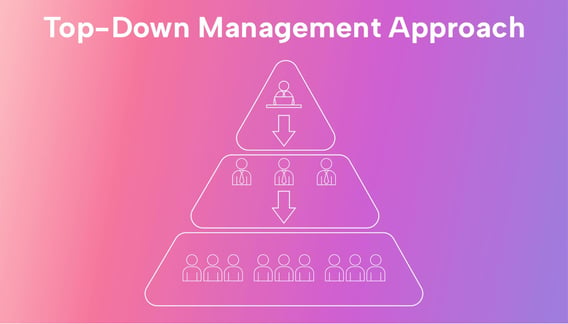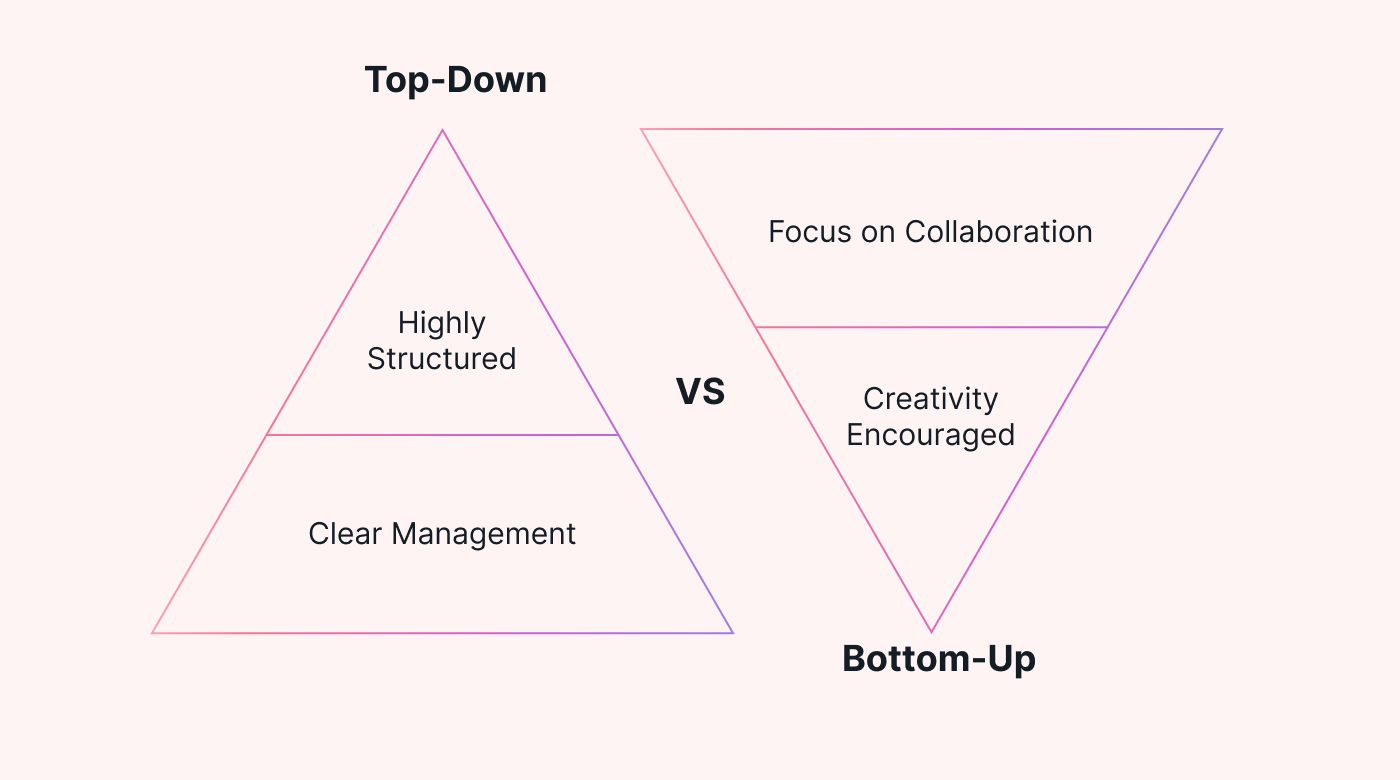Many experts claim that the top-down approach is useless in the modern working environment. They think you (as the owner or executive) shouldn’t be trying to lead projects or change initiatives directly but rely on bottom-up management.
But what do you do if your employees don’t have the experience to take your company in the right direction or if you have iron-clad deadlines and deliverable requirements?
The top-down approach is still relevant in 2023; you just need to know when to use it and how to minimize its downsides.
Top-down vs. bottom-up management: key differences
Top-down management is when upper management steers the ship — from vision to assigning specific tasks — while bottom-up focuses on including employees in planning and vision.
Here’s a quick breakdown of the key differences:
Top-down management:
- The approach is highly structured, with a detailed start-to-end project plan before you even begin.
- You source the vision and goals only from the owner and upper management.
- Every employee has clear tasks and timelines laid out by their direct manager.
- Bottom line: Managers decide what employees do and when based on goals set by the owner or executives.
Bottom-up management:
- Employee-driven planning: You hold workshops and meetings where you ask for input on goals and projects.
- Company leaders encourage initiative and creativity at all levels.
- There is typically more flexibility. In some companies, there’s even unstructured work time where employees can work “on what they want.” One example is Google’s infamous “20-percent rule.”
- Bottom line: Employees play a larger role within the organization, affecting prioritized projects, tasks/features that get focused on, and even company vision.
Read more about these differences in our dedicated guide to top-down vs. bottom-up management.
When a top-down management approach is the best choice
A top-down management approach is best for companies that deal with high costs of failure, strong regulations, or a combination of these other factors:
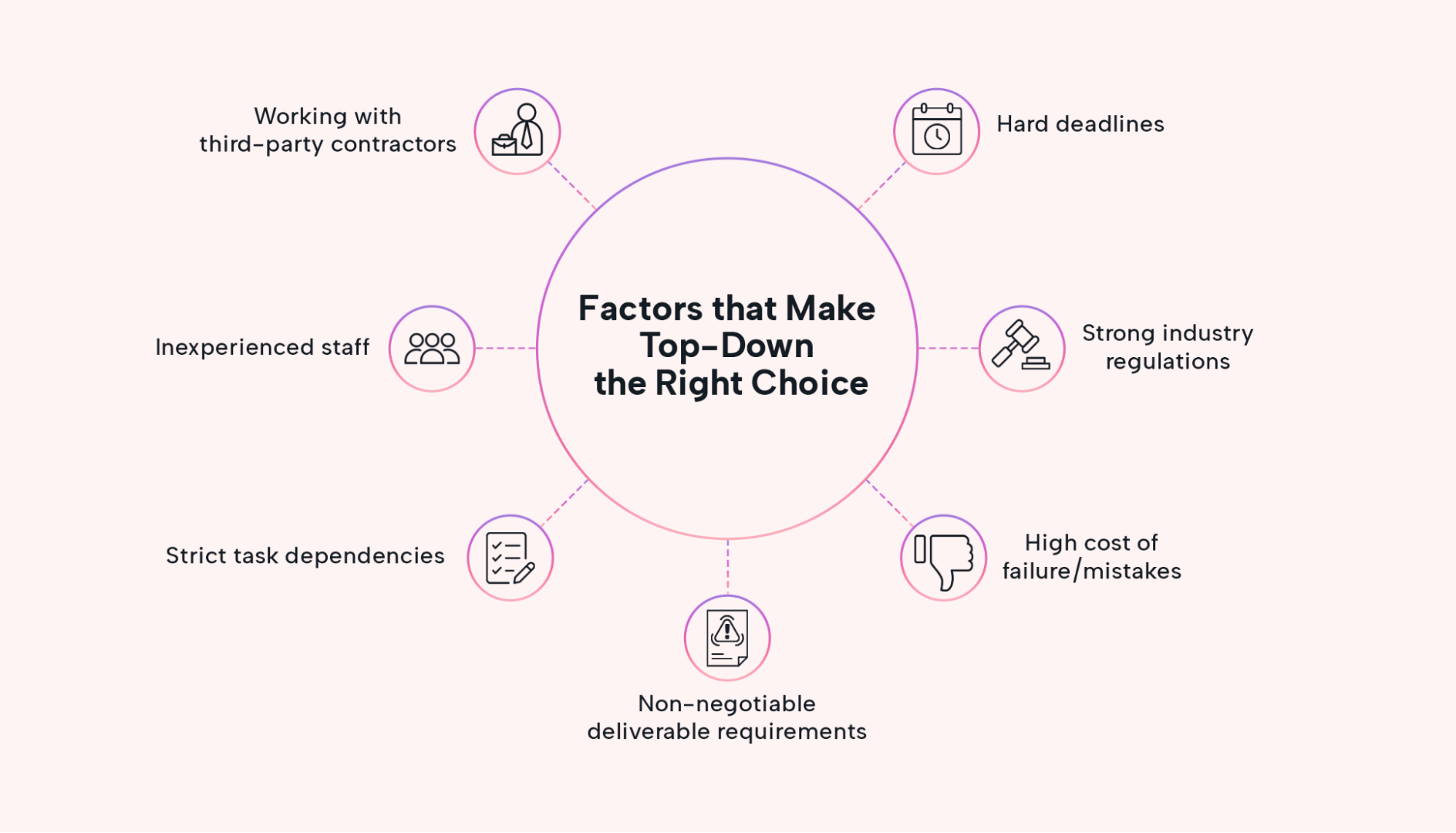 |
- Hard deadlines: Projects need to be done by a due date, or you pay heavy fines.
- Strong industry regulations: You risk getting fined if your product is not up to a certain standard.
- High cost of failure and mistakes: Seemingly small mistakes can cost thousands of dollars or days of production.
- Non-negotiable deliverable requirements: Every product delivered to your client must be up to specifications, or you’ll lose them.
- Strict task dependencies: You can’t simply skip to the next one if one task gets delayed.
- Inexperienced staff: High turnover rates or rapid growth mean a large part of your staff is relatively new.
- Working with third-party contractors: You can’t ask someone who doesn’t work for your company to lead it from the bottom up.
If you’re the owner of a food processing company, you’re subject to strong industry regulations, and small mistakes can cost you thousands of dollars. For example, a single-degree difference in cold storage temperature can mean you have to throw out a whole batch of food.
Worse, even something seemingly minor, like incorrect food labeling, can lead to the complete recall of an entire shipment.
Plus, because manual labor is a big component, you’re likely to have high turnover, constantly training new staff. So this makes it hard to simply “hand the mantle over” to your frontline staff and trust that they’ll know the right way forward.
In this case, a top-down approach with a highly standardized SOP (standard operating procedure) and clear roles and tasks is the right choice.
What is a real-life example of a top-down approach company?
Tesla is one of the most prominent examples of a successful company using a true top-down approach today. Elon Musk calls himself a “nanomanager” and prides himself on putting heavy pressure on his employees because “pressure creates diamonds.”
Should you try this approach in your own company? It’s probably not a great idea. Are your employees purpose-driven and strongly attached to your company and your vision? If not, you’ll experience much higher turnover rates than you’re used to.
Ruling with an iron fist rarely pays off in the long term. What you can learn from Musk is the importance of inspiring your employees and making them feel involved in your company’s goals. If you can make their work feel like it serves a real purpose, that’s a great antidote for disengagement, quiet quitting, and burnout.
When any deviation from the standard operating procedure likely costs your company big, it’s easy to default to micro-management. But it doesn’t have to be stressful for your employees.
If you can actively involve them in quality control as a community and get them involved in your organizational goals, it can boost worker engagement instead of hampering it. (We’ll discuss how you can do this in the next section.)
5 common top-down management issues — and how to work around them
Top-down management isn’t perfect — far from it. When done poorly, it leads to employees feeling stifled, micromanaged, and unengaged.
The good news is that through understanding its most prevalent issues, you can minimize or avoid them altogether. Here are five common issues with top-down management and how you can deal with them:
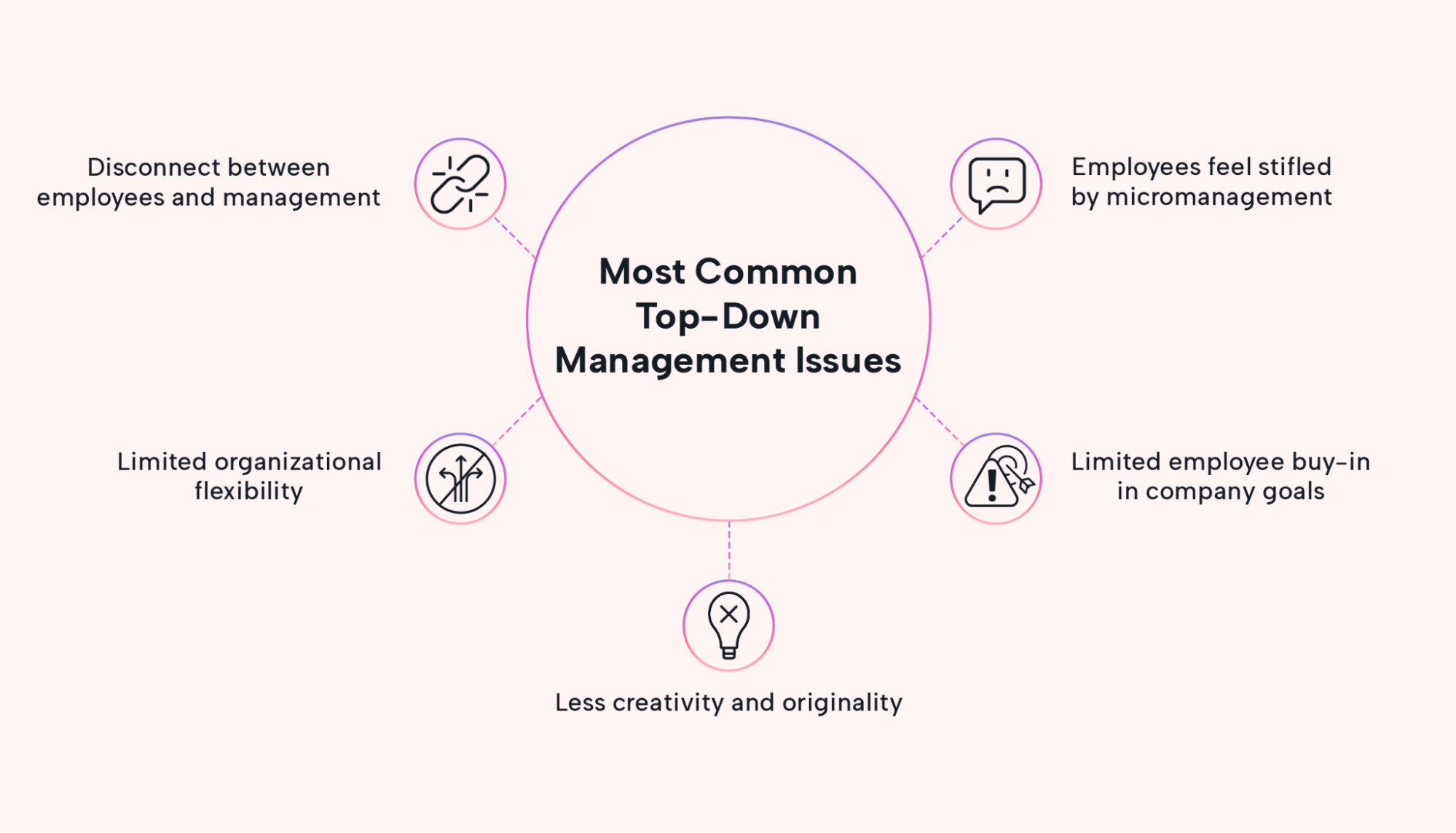 |
Talented employees feeling stifled through micromanagement
If you micromanage your best employees and disregard their level of talent, initiative, or experience, they’ll feel stifled and even disrespected.
Sure, some employees feel more comfortable with clearly defined tasks and don’t want to take initiative. But some want more for themselves and your company.
Recognize employees with a passion for their jobs and give them a clear channel to communicate their ideas and a vision for progressing in your organization.
A basic talent development program is a great first step. Outline the possible career progression types and offer to sponsor necessary courses or training. In a warehouse, you could sponsor forklift certification for warehouse pickers and package handlers.
This is the best way to keep hard-working, passionate employees for the long term.
Limited buy-in from employees in company goals and long-term projects
If you tell your employees, “We aim to become the market leader within five years.” How much do you think they care about that goal? Unless they have clear rewards tied to that goal, probably not that much.
So, how can you address this? The most effective option is to give your employees “skin in the game.” To make them feel that the goal will directly impact their lives as well, not just the owner or executives.
For startups, including stock options for lower-level employees is a good option. It makes everyone feel like they’re part of a collective effort to grow the company. It will immediately increase employee buy-in for growth-oriented goals.
For other businesses, using clear performance objectives with rewards (like a conditional bonus) is perhaps the best way to motivate your employees. But don’t turn an existing expected seasonal bonus (that employees treat as part of their salary) conditional after the fact. That’s a great way to ruin morale and increase turnover rates.
Disconnect between frontline employees and upper management
Only 55% of frontline employees felt connected to HQ, according to a 2021 study by Workplace. And 75% don’t trust their company to communicate transparently.
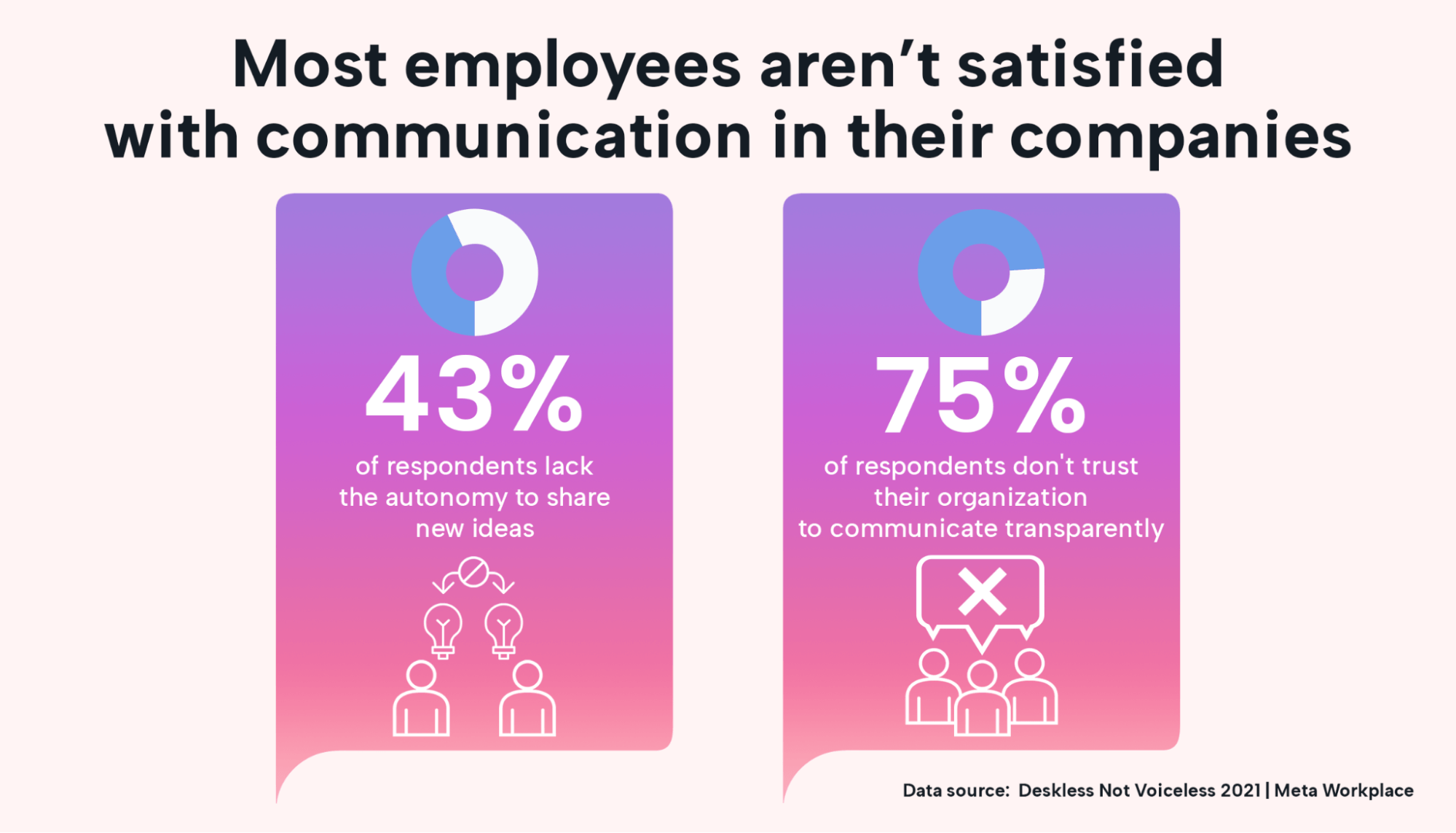 |
Even if your organization is better than average, many of your employees likely feel disconnected. So what can you do?
- Avoid silos by communicating on the same platforms.
- Open up and respect a clear channel of communication from employees to management here. Read: managers and the owner must actually answer emails or Slack messages.
- Share your vision boards and overall strategy with employees to get their input.
Less creativity and originality
If you’re in an industry where creative work is the backbone of your success (like a design agency or restaurant), inflexible top-down management is not your friend.
An agency owner or copy chief who tries to own the creative process will foster much less creativity. A restaurant owner who doesn’t listen to their kitchen and floor staff is more likely to end up in the next Hell’s Kitchen season than succeed in the long term.
In these settings, you need to strike the right balance with your management style. Be strict about deliverables and their quality, yes. But also give your employees the space to be creative.
In a restaurant, this could be letting every chef suggest new dishes for the seasonal menu and routinely asking floor staff for ideas on how to improve service.
Limited flexibility — slow to adapt to changing business environments
“Top-down is inflexible and slow.” That’s the rallying cry of proponents for the bottom-up approach.
If every minor decision needs signoff from you as the owner or an executive, then it’s true. Your organization is not flexible, and you will be slow to adapt to changes in client projects or the market around you.
To minimize this issue, clearly define how much leeway middle management and employees have to make adjustments for certain last-minute changes. For things like customer complaints, requests, or responding to a competitor’s campaign, speed is everything.
Empower your employees and teams to make informed decisions that help your company.
3 best practices to make the top-down approach work in 2023
To make the top-down approach work in a company today, you need to follow these three best practices:
Listen to your employees and adjust processes that stress them out
Sure, you have the final call when it comes to vision, goals, and the process. But if you don’t listen to your employees and make adjustments, you risk creating a workforce of “quiet quitters.”
And trying to reverse the trend is an uphill battle — only 23% of employees said they feel engaged at work in a 2023 Gallup study.
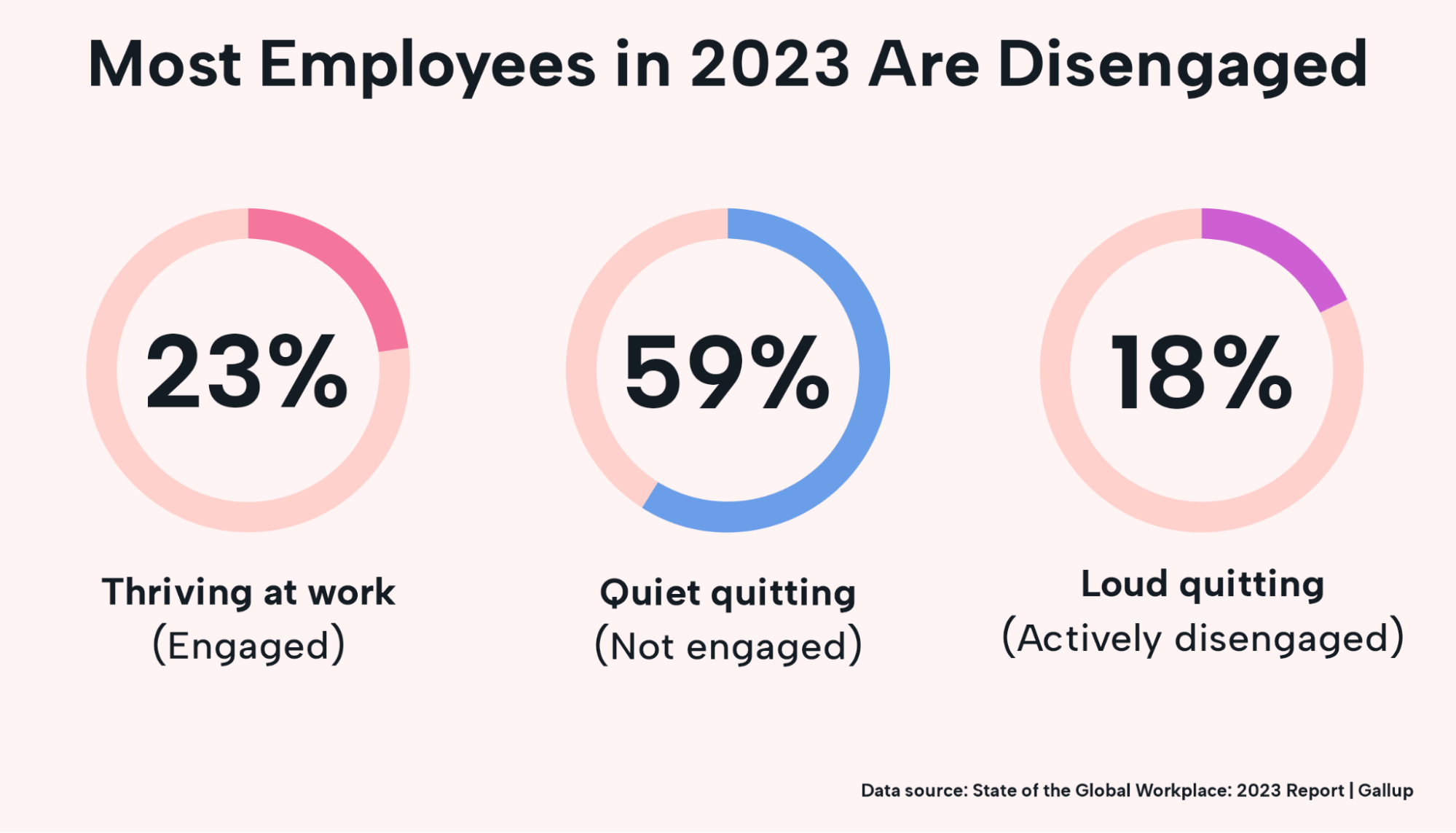 |
But when Gallup asked these “quiet quitters” what the company could do to improve, they immediately shared many ideas. So it’s clear that many disengaged workers want to make a difference but don’t feel heard by their managers or bosses.
So make sure they feel heard. Listen to them. There’s no shortcut here. You can’t just set up a “suggestions box” (digital or physical) and call it a job well done.
You have to set up processes and channels that make sure every employee feels heard.
- Train your managers to actively ask for suggestions.
- Actively implement suggestions and reward employees for making them.
- Adjust your high-level decision-making process to include workshops and meetings with employees.
Use smart solutions to avoid micromanaging without sacrificing visibility
It’s a lot easier to be an efficient manager when you take advantage of modern project management software. Use a shared work calendar or a Kanban board to delegate without micromanaging.
With full visibility of the progress of different tasks in a project, managers no longer need to actively ask for updates. It can help you cut down on unnecessary meetings and help your employees focus on their tasks without feeling stressed.
Give your employees a clear path to success
Don’t just focus on company goals. Outline goals for individual employees who show initiative and want to grow within and alongside the company.
When done right, this type of involved top-down leadership keeps your employees uniquely motivated and moving in the right direction. It can be as engaging as the bottom-up approach, without sacrificing the structure.
The four functions of project management are planning, organizing, leading, and controlling. The more you focus on leading and organizing, the less time you need to spend putting out fires in the controlling stage.
Gain more flexibility and give your employees space to work effectively with Motion
Want to get the best aspects of the top-down approach without the downsides? Motion can help you establish a centralized platform for managing tasks and schedules.
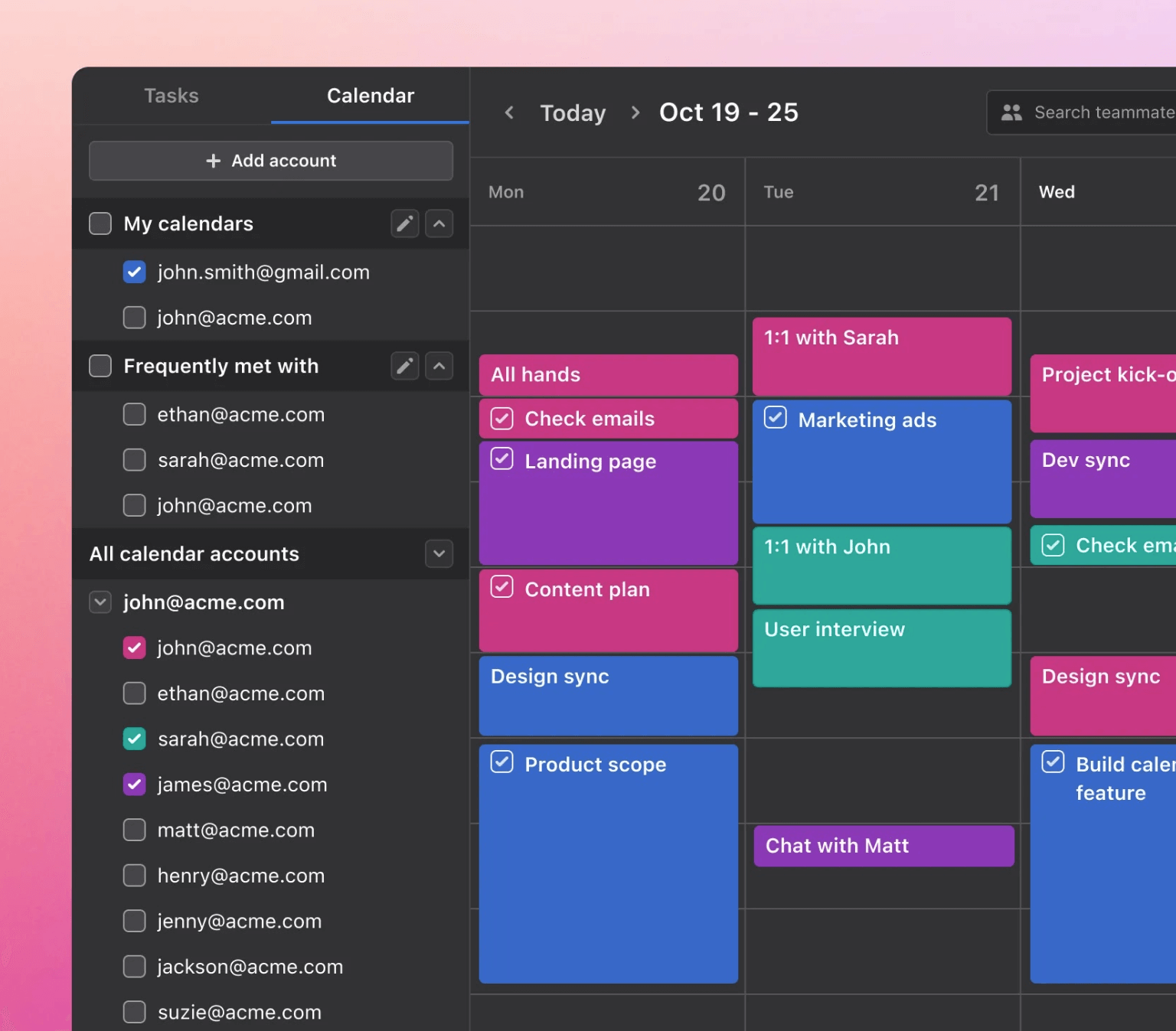 |
But what makes our team calendar different is its flexibility and our AI-powered automatic scheduling. Our algorithms consider task priority, dependencies, and deadlines. That means your teams are always working on the most pressing task, moving the project forward.
And here’s the kicker: if something comes up last minute, Motion handles that automatically. If James gets a 2-hour client call this Monday afternoon, Motion will automatically reschedule the landing page task to an open slot on his calendar.
Motion lets you administer an AI-assisted top-down strategy with much more flexibility and less need for mundane meetings about task assignments.
Sign up for our free 7-day trial to see how it can transform how you assign tasks and how your team works.

